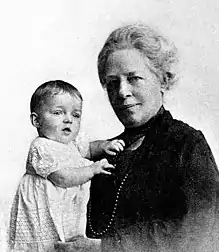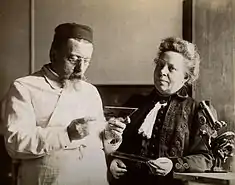Augusta Déjerine-Klumpke
Augusta Déjerine-Klumpke (15 October 1859 – 5 November 1927) was an American-born French medical doctor known for her work in neuroanatomy. She was the first female intern to work in a hospital in Paris.[1][2]
Augusta Déjerine-Klumpke | |
|---|---|
 Augusta and Jacqueline Déjerine-Klumpke | |
| Born | 15 October 1859 San Francisco, California |
| Died | 5 November 1927 (aged 68) Paris, France |
| Nationality | United States |
| Scientific career | |
| Fields | neuroanatomy |
| Influences | Joseph Jules Dejerine |

From a young age, Klumpke's family was supportive of her medical ambitions, going as far as to move to Paris so she and her sisters Anna Elizabeth Klumpke, Julia Klumpke, and Dorothea Klumpke could follow their pursuits. Despite facing scorn for being a woman in the medical field, she continued working on her medical studies both inside and outside the classroom, going as far as to work at laboratories at the Muséum d'Histoire Naturelle. She eventually went on to gain a reputation for her skills in the medical field and linguistically being able to speak both English and German. This led to her, along with Blanche Edwards-Pillet, being the first women externs in Paris Hospitals.[2]
During this time period, she explained what is today called Klumpke paralysis, or an injury to the nerves controlling arm movement. She worked under Alfred Vulpian, the dean at her former medical school who had opposed her attending medical school since she was both a woman and quite young at the time.[2]
During her life, her name appeared in fifty-six articles, some of which she had written herself. She also co-authored a two-volume book on the anatomy of nerve centers called Anatomie des Centres Nerveux with her husband Joseph Jules Dejerine. Klumpke was a member of several scientific societies, including the Société de Biologie (being the first elected female member) and the Société de Neurologie de Paris. She was given awards for her discoveries as well, including Officier de la Légion d'honneur and Chevalier de la Légion d'honneur.[2]
References
- Ulgen BO, Brumblay H, Yang LJ, Doyle SM, Chung KC (August 2008). "Augusta Déjerine-Klumpke, M.D. (1859–1927): a historical perspective on Klumpke's palsy". Neurosurgery. 63 (2): 359–66, discussion 366–7. doi:10.1227/01.NEU.0000320420.25035.A7. PMID 18797367.
- Creese, Mary (2004). Ladies in the Laboratory II. PO Box 317 Oxford OX2 9RU, UK: Scarecrow Press. pp. 61–63. LCCN 2003020846.CS1 maint: location (link)
Further reading
| Wikimedia Commons has media related to Augusta Déjerine-Klumpke. |
- Yildirim, F B; Sarikcioglu L (January 2008). "Augusta Dejerine-Klumpke (1859–1927) and her eponym". J. Neurol. Neurosurg. Psychiatry. 79 (1): 102. doi:10.1136/jnnp.2007.123448. PMID 18079304.
- Shoja, Mohammadali M; Tubbs R Shane (August 2007). "Augusta Déjerine-Klumpke: the first female neuroanatomist". Clinical Anatomy. 20 (6): 585–7. doi:10.1002/ca.20474. PMID 17330887.
- Bogousslavsky, Julien (2005). "The Klumpke family—memories by Doctor Déjerine, born Augusta Klumpke". Eur. Neurol. 53 (3): 113–20. doi:10.1159/000085554. PMID 15860915.
- Ole Daniel Enersen. "Augusta Marie Dejerine-Klumpke". Whonamedit? A dictionary of medical eponyms. Retrieved 28 May 2014.